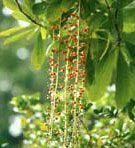The green flowers of the Lagerstroemia tree are used for treating eczema by extracting juice or soaking in alcohol to alleviate toothache. The tree’s bark contains a significant amount of tannin, which is beneficial for treating diarrhea and stomach pain. Lagerstroemia is also known by other names such as the flowering tree, the ship tree, and the Ngoc Nhi Tam Lang.
 |
|
Lagerstroemia Flowers |
The tree can grow to a height of 8-10 meters. Its thick, rough bark is dark brown in color. The leaves are arranged alternately but are usually concentrated at the tips of the branches, with serrated edges and a glossy dark green upper surface; the leaf stalks are red. The flowers are light red, with the stamens and style being dark red. The fruit is four-sided with protruding edges, each containing a seed in a vertical groove.
This tree grows naturally in sparse forests and along riverbanks near water. It is also cultivated for ornamental purposes; sometimes, it is simply a branch segment with numerous roots submerged in water, with some young branches rising above, creating a visually appealing and attractive sight.
Young Lagerstroemia leaves have a slightly astringent taste and are often used as salad greens, either on their own or mixed with young fiddlehead ferns in fish salad dishes.
The bark of the Lagerstroemia tree can be harvested year-round. The outer cork layer is removed, cleaned, sliced, and then dried or dehydrated. It is used as medicine for treating stomach pain, diarrhea, and fever due to its high tannin content (16%). For use, 8-16 grams of the bark is boiled in 400ml of water until 100ml remains, and it is consumed in two doses throughout the day.
Unripe Lagerstroemia fruits can be juiced and applied externally to treat eczema or ground and soaked in alcohol to alleviate toothache.
The roots contain saponins and have a bitter taste, which can be crushed to make fish bait.
According to foreign literature, Lagerstroemia roots are used as a digestive stimulant, seeds can treat eye pain, and leaves are beneficial for diarrhea. In the Philippines, the bark is used to treat wounds, and when boiled and consumed, it can help alleviate stomach pain.
Pharmacist ĐỖ HUY BÍCH


















































